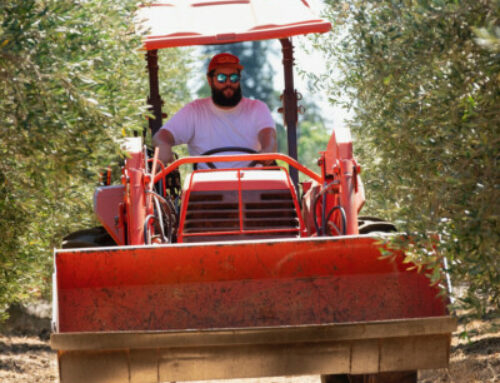Published in the July 19 – August 1, 2017 issue of Gilroy Life
By Kate Russell

Kate Russell
The temperature impacts every stage of plant growth and fruit production.
We all know that most plant life processes stop when it gets really cold outside, but did you know that the same thing happens when it is hot?
Temperature sweet spots
Each plant species has a minimum, maximum, and optimal temperature range for its different life processes: germination, seedling growth, vegetative growth, and reproductive growth.
Some plants, such as peas, lettuce, broccoli, and spinach, prefer cooler weather (60°F), while squash, melons, peppers, tomatoes and corn prefer hot weather (80 to 90°F). Normal responses to temperature are what make our harvest possible. And sometimes we get 90°F weather in April.
Plant responses to heat and cold
Just as the symptoms of not enough water look a lot like the symptoms of too much water, plants respond to both heat and cold in very similar ways. They close the tiny pores, called stoma, on the underside of leaves, to retain moisture.
If this isn’t sufficient protection, they wilt. Then leaves begin to dry and burn at the tips and edges, and tender new growth can die. Prolonged exposure can lead to twig and branch dieback, or complete loss of the plant.
What happens when it gets too hot?
Excessive heat (above 90°F) can lead to water stress and sunburn damage. It can also interfere with pollination. Pollen loses its viability at temperatures over 95°F and seedlings die at 125°F.
While Morgan Hill gardens never see temperatures that high, sunlight reflected off hot pavement can easily scorch nearby plants.
In crops such as corn, a sudden heat wave can reduce harvest by 80 to 90 percent. Studies have shown that high temperatures can reduce the amount of time a plant takes to produce fruit, lowering both size and quality. Plants also tend to stay smaller. You cannot control the weather, but there are things you can do to help your garden and landscape plants survive temperature extremes.
Sometimes water just isn’t enough
Deep roots and overall good health go a long way toward helping a plant protect itself. Shallow root systems dry out quickly and are more sensitive to summer heat. Watering plants deeply and allowing the soil to dry out between waterings encourages roots to go deeper. And sometimes water isn’t enough.
A thick layer of aged compost or other mulching material placed around trees, shrubs, and other plants can stabilize soil temperature and provide a slow-release of nutrients.
Just be sure the mulch does not touch the trunk. Avoid using fertilizer when extreme temperatures are expected, and be sure to leave as much leaf cover as possible. Excessive pruning can make plants vulnerable to sunburn.
Artificial protection from the elements can take the form of shade structures, pergolas, row covers, umbrellas, and shade cloth.
Blocking even a little sunlight on a hot day can help your plants get through the worst of it without sunburn damage or water stress.
An ounce of prevention
You can eliminate much of the work related to temperature extremes by selecting plants best suited to the Morgan Hill micro-climate (natives are an easy choice), and place them in locations suitable to their species.
And be sure to install plants at a time of year when they will have enough time to develop a strong root system.
Finally, have your soil tested by a reputable lab, to find out exactly what you are working with, and continually strive to improve soil structure.
Healthy soil makes healthy plants. Healthy plants can tolerate heat and cold better than plants marginalized by poor soil, insufficient irrigation, or improper care.
Kate Russell is a member of the UCCE Master Gardeners of Santa Clara County. She wrote this for Morgan Hill Life.






